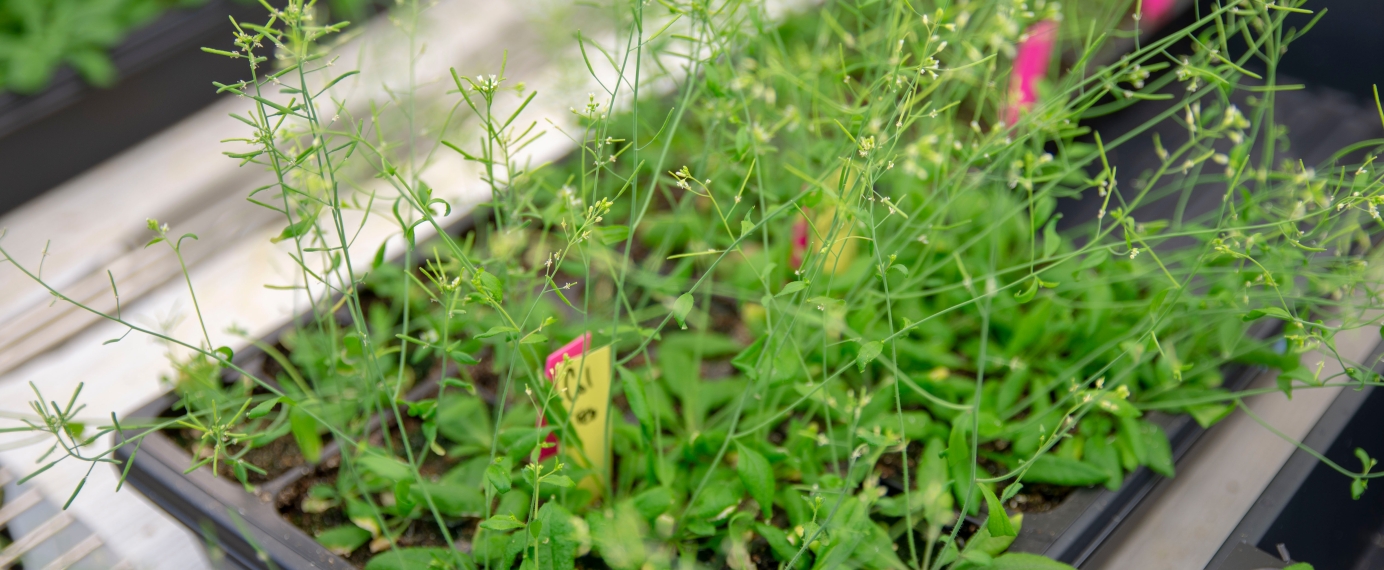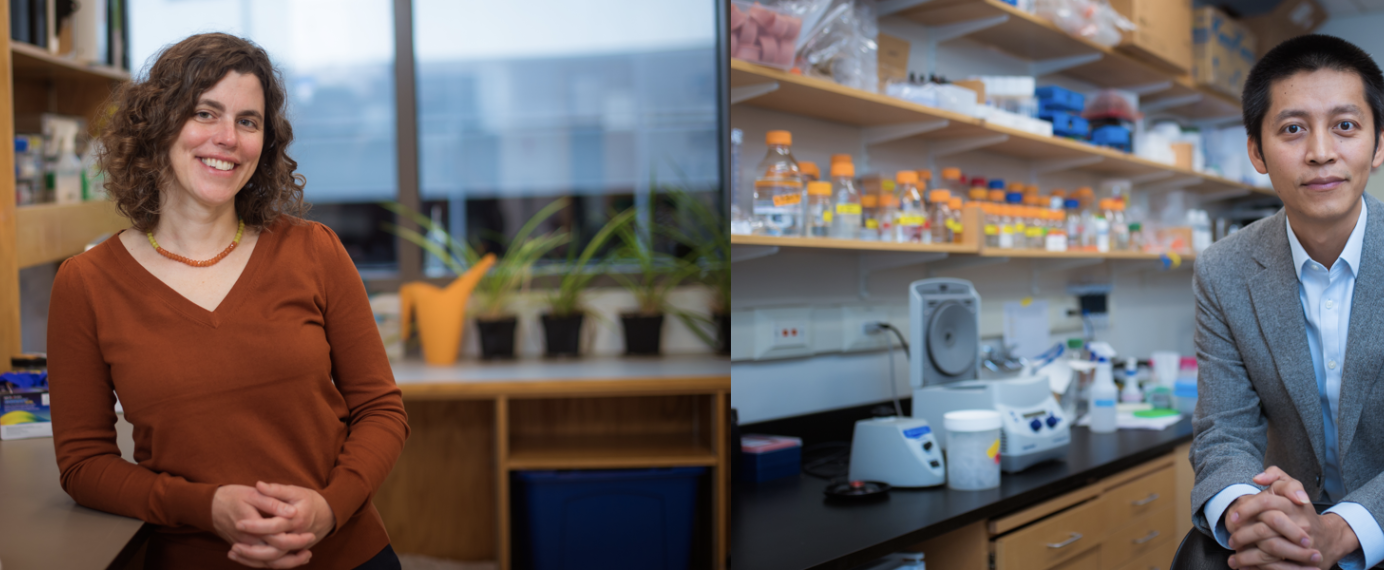Using plant biology to help address climate change

Arabidopsis plants
Conor Gearin/Whitehead Institute
Mitigating the changing climate’s negative impact on agriculture and food security — and reducing agriculture’s contribution to atmospheric temperature increase — are both fundamental to humanity’s future.
Whitehead Institute Members Mary Gehring and Jing-Ke Weng are leading two research studies designed to help address that dual imperative. They are working, first, to ensure that yields of agricultural crops do not continue to decrease due to climate change’s effects on plant growth; and second, to reduce the greenhouse gas emissions produced by agricultural fertilizer. Gehring and Weng are also both associate professors of biology and Massachusetts Institute of Technology (MIT); and their studies are key to a multidisciplinary project chosen to be part of the MIT Climate Grand Challenges initiative, Revolutionizing Agriculture with Low-emissions, Resilient Crops.
Promoting crop resilience
For most of human history, climate change occurred gradually, over hundreds or thousands of years. That pace allowed plants to adapt to variations in temperature, precipitation, and atmospheric composition. However, human-driven climate change has occurred much more quickly and crop plants have suffered: Crop yields are down in many regions, as is seed protein content in cereal crops.
“If we want to ensure an abundant supply of nutritious food for the world, we need to develop fundamental mechanisms for bioengineering a wide variety of crop plants that will be both hearty and nutritious in the face of our changing climate,” says Gehring, who holds the Institute’s Landon T. Clay Career Development Chair. In her previous work, she has shown that many aspects of plant reproduction and seed development are controlled by epigenetics — that is, by information outside of the DNA sequence. She has been using that knowledge and the research methods she has developed to identify ways to create varieties of seed-producing plants that are more productive and resilient than current food crops.
But plant biology is complex and while it is possible to develop plants that integrate robustness-enhancing traits by combining dissimilar parental strains, scientists are still learning how to ensure that the new traits are carried forward from one generation to the next. Gehring, who is also an associate professor of biology at Massachusetts Institute of Technology (MIT), explains: “Plants that carry the robustness-enhancing traits have ‘hybrid vigor,’ and we believe that the perpetuation of those traits is controlled by epigenetics. Right now, some food crops, like corn, can be engineered to benefit from hybrid vigor, but those traits are not inherited. That’s why farmers growing many of today’s most productive varieties of corn must purchase and plant new batches of seeds each year. Moreover, many important food crops have not yet realized the benefits of hybrid vigor.”
The project Gehring leads, “Developing Clonal Seed Production to Stabilize Hybrid Vigor,” aims to enable food crop plants to create seeds that are both more robust and genetically identical to the parent — and thereby able to pass beneficial traits from generation to generation.
The process of clonal (or asexual) production of seeds that are genetically identical to the maternal parent is called apomixis. Gehring says, “Because apomixis is present in 400 flowering plant species — about one percent of flowering plant species — it is probable that genes and signaling pathways necessary for apomixis are already present within crop plants. Our challenge is to tweak those genes and pathways so that the plant switches reproduction from sexual to asexual.”
The project will leverage the fact that genes and pathways related to autonomous asexual development of the endosperm — a seed’s nutritive tissue — exist in the model plant Arabidopsis thaliana. In previous work on Arabidopsis, Gehring’s lab researched a specific gene that, when mis-regulated, drives development of an asexual endosperm-like material. “Normally, that seed would not be viable,” she notes. “But we believe that by epigenetic tuning of the expression of additional relevant genes, we will enable the plant to retain that material — and help achieve apomixis.”
If Gehring and her colleagues succeed in creating a gene-expression “formula” for introducing endosperm apomixis into a wide range of crop plants, they will have made a fundamental and important achievement. Such a method could be applied throughout agriculture to create and perpetuate new crop breeds able to withstand their changing environments while requiring less fertilizer and fewer pesticides.

Mary Gehring and Jing-Ke Weng
Gretchen Ertl/Whitehead Institute
Creating “self-fertilizing” crops
Roughly a quarter of greenhouse gas (GHG) emissions in the United States are a product of agriculture. Fertilizer production and use accounts for one third of those emissions and includes nitrous oxide, which has heat-trapping capacity 298-fold stronger than carbon dioxide. Most artificial fertilizer production also consumes huge quantities of natural gas and uses minerals mined from non-renewable resources. After all that, much of the nitrogen fertilizer becomes run-off that pollutes local waterways. For those reasons, it is important to greatly reduce use of human-made fertilizers.
One tantalizing approach is to cultivate cereal crop plants — which account for about 75 percent of global food production — capable of drawing nitrogen from metabolic interactions with bacteria in the soil. Weng leads an effort to do just that: genetically bioengineer crops such as corn, rice, and wheat to, essentially, create their own fertilizer through a symbiotic relationship with nitrogen-fixing microbes.
“Legumes such as bean and pea plants can form root nodules through which they receive nitrogen from rhizobia bacteria in exchange for carbon,” explains Weng, who is also an associate professor of biology at MIT. “This metabolic exchange means that legumes release far less GHGs — and require far less investment of fossil energy — than do cereal crops, which use a huge portion of the artificially produced nitrogen fertilizers employed today.
“Our goal is to develop methods for transferring legumes’ ‘self-fertilizing’ capacity to cereal crops,” Weng says. “If we can, we will revolutionize the sustainability of food production.”
The project — formally entitled “Mimicking legume-rhizobia symbiosis for fertilizer production in cereals” — will be a multi-stage, five-year effort. It draws on Weng’s extensive studies of metabolic evolution in plants and his identification of molecules involved in formation of the root nodules that permit exchanges between legumes and nitrogen-fixing bacteria. It also leverages his expertise in reconstituting specific signaling and metabolic pathways in plants.
Weng and his colleagues will begin by deciphering the full spectrum of small-molecule signaling processes that occur between legumes and rhizobium bacteria. Then they will genetically engineer an analogous system in non-legume crop plants. Next, using state-of-the-art metabolomic methods, they will identify which small molecules excreted from legume roots prompt a nitrogen/carbon exchange from rhizobium bacteria. Finally, the researchers will genetically engineer the biosynthesis of those molecules in the roots of non-legume plants and observe their effect on the rhizobium bacteria surrounding the roots.
While the project is complex and technically challenging, its potential is staggering. “Focusing on corn alone, this could reduce the production and use of nitrogen fertilizer by 160,000 tons,” Weng notes. “And it could halve the related emissions of nitrous oxide gas.